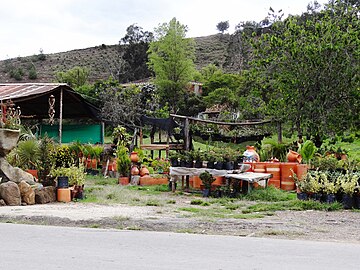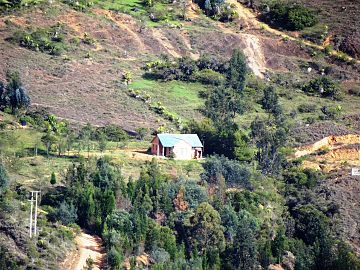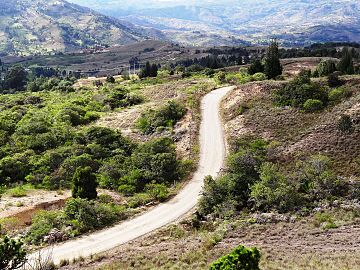Contents
Ráquira, is a municipality and town in Boyacá Department, Colombia, part of the subregion of the Ricaurte Province. Ráquira is situated on the Altiplano Cundiboyacense and the urban center at an altitude of 2,150 metres (7,050 ft). It borders Tinjacá and Sutamarchán in the north, Guachetá, Cundinamarca in the south, in the east Sáchica and Samacá and in the west San Miguel de Sema and Lake Fúquene.[1]
Etymology
In Chibcha, Ráquira means "Village of the pans".[2]
History
The area of Ráquira was inhabited by the Muisca in the centuries before the Spanish conquest of the central highlands of the Colombian Andes. Already in those times Ráquira was famous for its ceramics due to the clay of the area.[3][4]
In March 1537 conquistador Gonzalo Jiménez de Quesada crossed the valley around Ráquira. Modern Ráquira was founded on October 18, 1580 by friar Francisco de Orejuela.[1]
Economy
About three quarters of the economy of Ráquira is centered on the handcrafts. Other economical activities are agriculture, livestock farming and mining.[1]
Tourism
Ráquira is famous in Colombia for its colony of artisans, who produce traditional northern Andean pottery & hand-woven goods. The Sunday market is especially a popular time to visit. Ráquira is also known for its colorful houses that contrast with the famous nearby town of Villa de Leyva.[5]
Gallery
-
Central square and church Ráquira
-
Church
-
Church
-
Church interior
-
Arts and crafts in Ráquira
-
Crafts
-
Clay sculpture
-
Ceramic sculpture
-
Rural area of Ráquira
-
Farm in rural area
-
Road in rural area
-
Ráquira River
References
- ^ a b c (in Spanish) Official website Ráquira
- ^ (in Spanish) Etymology Ráquira - Excelsio.net
- ^ (in Spanish) Muisca history and ceramics in Ráquira
- ^ (in Spanish) Ceramics of Ráquira because of the clay present there
- ^ Crafts in Ráquira














